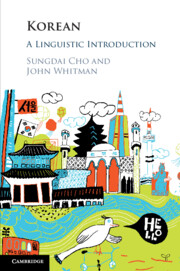2 - Historical Background
from Part I - Background
Published online by Cambridge University Press: 14 November 2019
Summary
Chapter 2 outlines the history of the Korean language, starting from the internal reconstruction of proto-Korean through Old Korean, Middle Korean, Modern Korean and Contemporary Korean. Old Korean designates the language of Silla up until the end of the Unified Silla period in the tenth century. Middle Korean covers the Koryo (Early Middle Korean) and Choson (Late Middle Korean) periods up until the end of the sixteenth century. This relatively brief period has also seen events of great linguistic importance: the Japanese colonial period (1909 to 1945), which saw the importation of Japanese loans and loans from Western languages through Japanese; the Korean War, resulting in the division of the two Koreas; and finally the turbulent postwar period, which has seen the final disappearance of Chinese characters in the Democratic People’s Republic of Korea and the near complete disappearance of them in the Republic of Korea, and the ever greater impact of neologisms and loans from electronic media and the internet.
- Type
- Chapter
- Information
- KoreanA Linguistic Introduction, pp. 9 - 29Publisher: Cambridge University PressPrint publication year: 2019



